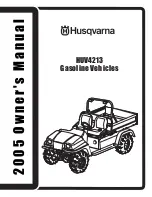
-7-
GENERAL INFORMATION
- 7 -
Cotter Pins
A cotter pin is a split metal pin inserted into a hole or slot to prevent a fastener from loosening. In
certain applications, such as the rear axle on an UTV or motorcycle, the fastener must be secured in
this way. For these applications. A cotter pin and castellated (slotted) nut is used.
To use a cotter pin, first make sure the diameter is correct for the hole in the fastener. Aster
correctly tightening the fastener and aligning the holes, insert the cotter pin through the hole and bend
the ends over the fastener, Unless instructed to do so, never loosen a tightened fastener to align the
holes. If the holes do not align. Tighten the fastener enough to achieve alignment
Cotter pins are available in various diameters and lengths. Measure the length from the bottom of
the head to the tip of the shortest pin
Snap Rings and E-clips
Snap rings (Figure 1) are circular-shaped metal
retaining clips. They secure parts in place on parts
such as shafts. External type snap rings are used to
retain items on shafts. Internal type snap rings secure
parts within housing bores. In some applications. in
addition to securing the component(s). snap rings of
varying thicknesses also determine endplay. These
are usually called selective snap rings.
The two basic types of snap rings are machined
and stamped snap rings. Machined snap rings (Figure
2) can be installed in either direction. Because both
faces have sharp edges. Stamped snap rings (Figure
3) are manufactured with a sharp and a round edge.
When installing a stamped snap ring in a thrust
application, install the sharp edge facing away from
the part producing the thrust.
E-clips are used when it is not practical to use a
snap ring. Remove E-clips with a flat blade
screwdriver by prying between the shaft and E-clip. To
install an E-clip. Center it over the shaft groove and
push or tap it into place
Observe the following when installing snap rings:
1.
Remove and install snap rings with snap rings
pliers. Refer to Basic Tools in this chapter
2.
In some applications. it may be necessary to
replace snap rings after removing them
3.
Compress or expand snap rings only enough to
install them. If overly expanded. Lose their
retaining ability
4.
After installing a snap ring. Make sure it seats completely
5.
Wear eye protection when removing and installing snap rings
Содержание 1000GTR
Страница 2: ......
Страница 14: ......
Страница 93: ...7 SPECIFICATIONS 79 HYDROGRAPHIC CHART Hydrographic chart Pressure...
Страница 94: ...8 SPECIFICATIONS 80 LUBRICATION OIL WAY LUBRICATION OIL WAY Pressure splashing oil...
Страница 209: ...5 CHASSIS 195 No Part Name Qty Remarks 19 Spring cushion 10 16 20 Waved seal 2 21 Waved seal 2 22 Shed cross bar 1...
















































